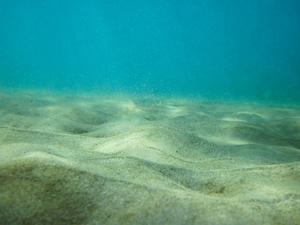Difference between revisions of "Insoluble"
| (5 intermediate revisions by the same user not shown) | |||
| Line 1: | Line 1: | ||
| + | ==Key Stage 2== | ||
| + | ===Meaning=== | ||
| + | An [[insoluble]] [[material]] is one that cannot be [[dissolve]]d in [[water]]. | ||
| + | |||
| + | ===About Insoluble Materials=== | ||
| + | : [[Insoluble]] is the opposite of [[soluble]]. | ||
| + | : When an [[insoluble]] [[material]] is put in [[water]] it can still be seen, no matter how much you stir the [[water]]. | ||
| + | : An [[insoluble]] [[material]] will make [[water]] appear cloudy. | ||
| + | |||
| + | ===Examples=== | ||
| + | {| | ||
| + | |[[File:SandWaterMixture.png|center|300px]] | ||
| + | | style="height:20px; width:300px; text-align:center;" |Sand is [[insoluble]] because it does not [[dissolve]] in [[water]]. | ||
| + | |} | ||
| + | |||
==Key Stage 3== | ==Key Stage 3== | ||
===Meaning=== | ===Meaning=== | ||
| − | An [[insoluble]] [[material]] is one that cannot be easily [[dissolve]]d in [[water]]. | + | An [[insoluble]] [[material]] is one that cannot be easily [[dissolve]]d in a [[solvent]]. |
| + | |||
| + | ===About Insoluble Materials=== | ||
| + | : [[Insoluble]] is the opposite of [[soluble]]. | ||
| + | : When an [[insoluble]] [[material]] is put in a [[solvent]] (usually [[water]]) it can still be seen, no matter how much you stir the [[solvent]]. | ||
| + | : An [[insoluble]] [[material]] will make the [[solvent]] appear cloudy. | ||
| + | : Many [[material]]s are [[soluble]] in some [[solvent]]s and [[insoluble]] in other [[solvent]]s. | ||
| + | : Many [[material]]s we call [[insoluble]] can [[dissolve]] in a [[solvent]] a small amount but so little that the rest sinks to the bottom of the [[solvent]] to form a [[sediment]]. | ||
| + | |||
| + | ===Examples=== | ||
| + | {| | ||
| + | |[[File:SandWaterMixture.png|center|300px]] | ||
| + | | style="height:20px; width:300px; text-align:center;" |Sand is referred to as [[insoluble]] in [[water]] because very little can [[dissolve]] in the [[water]]. Only a small amount [[dissolve]]s before the [[water]] is [[Saturated Solution|saturated]] with the [[sand]] and the rest sinks to the bottom of the [[water]]. | ||
| + | |} | ||
===References=== | ===References=== | ||
Latest revision as of 15:39, 13 December 2019
Contents
Key Stage 2
Meaning
An insoluble material is one that cannot be dissolved in water.
About Insoluble Materials
- Insoluble is the opposite of soluble.
- When an insoluble material is put in water it can still be seen, no matter how much you stir the water.
- An insoluble material will make water appear cloudy.
Examples
| Sand is insoluble because it does not dissolve in water. |
Key Stage 3
Meaning
An insoluble material is one that cannot be easily dissolved in a solvent.
About Insoluble Materials
- Insoluble is the opposite of soluble.
- When an insoluble material is put in a solvent (usually water) it can still be seen, no matter how much you stir the solvent.
- An insoluble material will make the solvent appear cloudy.
- Many materials are soluble in some solvents and insoluble in other solvents.
- Many materials we call insoluble can dissolve in a solvent a small amount but so little that the rest sinks to the bottom of the solvent to form a sediment.
Examples
| Sand is referred to as insoluble in water because very little can dissolve in the water. Only a small amount dissolves before the water is saturated with the sand and the rest sinks to the bottom of the water. |
